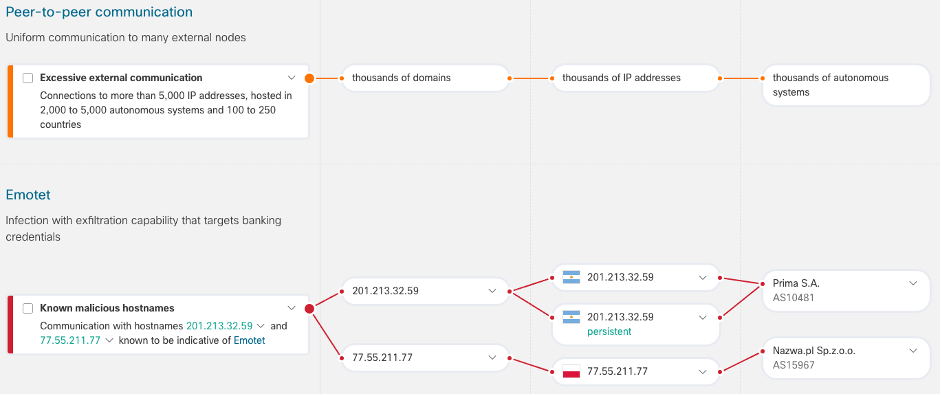
Threat Trends: DNS Security, Part 2
March 23, 2021
The philosophy and practice of our hybrid workplace
March 25, 2021What are you missing when you don’t enable global threat alerts?

Network telemetry is a reservoir of data that, if tapped, can shed light on users’ behavioral patterns, weak spots in security, potentially malicious tools installed in enterprise environments, and even malware itself.
Global threat alerts (formerly Cognitive Threat Analytics known as CTA) is great at taking an enterprise’s network telemetry and running it through a pipeline of state-of-the-art machine learning and graph algorithms. After processing the traffic data in batch in a matter of hours, global threat alerts correlates all the user behaviors, assigns priorities, and groups detections intelligently, to give security analysts clarity into what the most important threats are in their network.
Smart alerts
All detections are presented in a context-rich manner, which gives users the ability to drill into the specific security events that support the threat detections grouped eventually into alerts. This is useful because just detecting potentially malicious traffic in your infrastructure isn’t enough; analysts need to build an understanding of each threat detection. This is where global threat alerts saves you time, investigating alerts and accelerating resolution.

As depicted below in Figure 2, users can both change the severity levels of threats and rank high-priority asset groups from within the global threat alerts portal. This enables users to customize their settings to only alert them to the types of threats that their organizations are most concerned about, as well as to indicate which resources are most valuable. These settings allow the users to set proper context for threat alerts in their business environment.

Global threat alerts are also presented in a more intuitive manner, with multiple threat detections grouped into one alert based on the following parameters:
- Concurrent threats: Different threats that are occurring together.
- Asset groups value: Group of threats occurring on endpoints that belong to asset groups with similar business value.

Rich detection portfolio
Global threat alerts is continuously tracking and evolving hundreds of threat detections across various malware families, attack patterns, and tools used by malicious actors.
All these outcomes and detections are available for Encrypted Traffic Analytics telemetry (ETA) as well, which allows users to find threats in encrypted traffic without the need to decrypt that traffic. Moreover, because ETA telemetry contains more information than traditional NetFlow, the global threat alerts’ research team has also developed specific classifiers that are capable of finding additional threats in this data, such as with algorithms that are focused on detecting malicious patterns in the path and the query of a URL.
The global threat alerts’ research team is continuously engaged in dissecting new security threats and implementing the associated threat intelligence findings into hundreds of specialized classifiers. These classifiers are targeted at revealing campaigns that attackers are using on a global scale. Examples of these campaigns include the Maze ransomware and the njRAT remote access trojan. Numerous algorithms are also designed to capture generic malicious tactics like command-and-control traffic, command-injections, or lateral network movements.
Risk map of the internet
There are numerous algorithms focused on uncovering threat infrastructure in the network. These models are continuously discovering relationships between known malicious servers and new servers that have not yet been defined as malicious, but either share patterns or client bases with the known malicious servers. These models also constantly exchange newly identified threat intelligence with other Cisco security products and groups, such as Talos.

This complex approach of threat detection consists of multiple layers of machine learning algorithms to provide high-fidelity detections that are always up-to-date and relevant, as researchers are updating the machine models constantly. Additionally, all this computation is done in the cloud and utilizes only network telemetry data to derive new findings. The findings and alerts are presented to users in Secure Network Analytics and Secure Endpoint.
Global threat alerts uses state-of-the-art algorithms to provide high-fidelity, unique threat detections for north-south network traffic, Smart Alerts to help prioritize and accelerate resolutions, and a risk map to provide greater context and understanding of how threats span across the network.
You can enable it in Secure Network Analytics or Web Appliance in conjunction with your Secure Endpoint license.
Learn more about Cisco Secure Network Analytics

